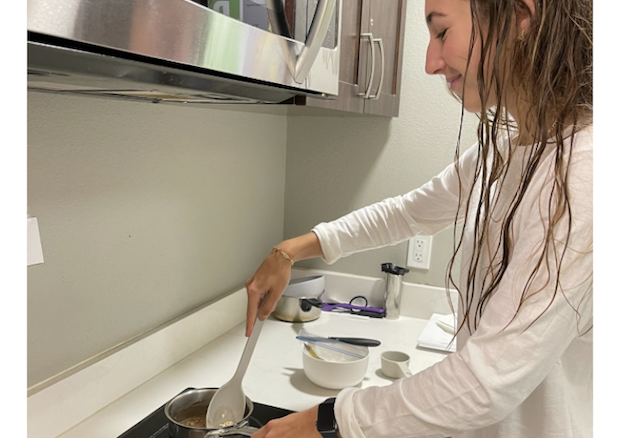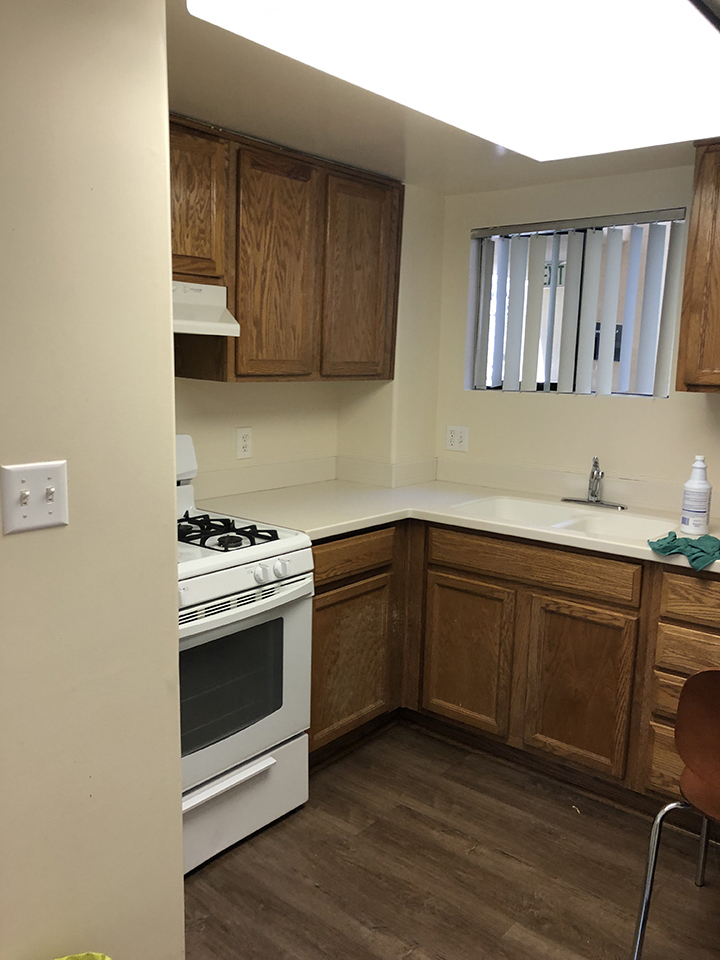
From microwave mac and cheese to pan-seared ribeye, college cooking looks different for everyone.
Students at Pepperdine University live in one of eight different types of housing on campus. Where students live, and whether they have just a microwave or a full kitchen, can change what they eat.
“It’s always good to be able to cook something for myself really quickly,” said Andrean Pokala, a first-year integrated marketing communication major. “Sometimes I make things that are really extravagant. Like the other day, I made myself a ribeye.”
There is no one-size-fits-all for food. Missing home, nutrition needs, making environmentally conscious choices, COVID-19 regulations, time and location can all be factors that play into the decision of whether or not to cook.
First-year students navigate dorm cooking
Whereas some residence halls have multi-student, public cooking facilities, only apartment dwellers have their own kitchens.
First-year students often have the most limited options. They are stuck on a meal plan, and usually just have a microchill unit — a fridge with a freezer compartment and a microwave.
The main challenge with limited space to cook is also minimum access to appliances.
“Freshman and some sophomores have the most difficulty,” Pepperdine’s Dietitian-Nutritionist Kathrine McCune said. “Many of the students haven’t had experience eating most of their meals away from home. Use of Pepperdine’s Dining Services meal plan encourages students to eat on campus. First year students often find it difficult to navigate both eating well and getting to class on time.”
Many first-year students keep frozen meals in their dorms for something quick.
First-year psychology major Skylar Allen has found that Trader Joe’s Diner Mac n’ Cheese is the perfect go-to meal for a busy day.
Students like Michael Sugimoto, a first-year political science and economics major, have experimented with the use of microchill units.
In the beginning of the year, when testing eating in his dorm, Sugimoto found that storing food is one of the most difficult parts.
“You can only have food and store it for so long before it goes bad,” Sugimoto said.
Sugimoto and his Pepper House roommate, Liam Zieg, were not able to rent a microchill unit because the university ran out. Sugimoto and Zieg were able to purchase one at the store.
Microchill units can be useful for storage but difficult to cook sustainable meals with.
“I really wish I could bring in an airfryer,” Sugimoto said. “Or something else I could use to cook food.”
Sugimoto has found the mini fridge to be most useful for drinks.
First-year IMC major Marla Steel is one of many students living in the first-year suite-style housing. Steel’s situation is uncommon for first-year housing students, as she has access to a mini kitchenette with a stove, microwave and sink.
Steel often uses just the microwave to make a meal.
“I’ll warm up some frozen veggies,” Steel said. “Get chicken breast slices and I’ll eat that with microwavable rice, and that will be a good meal.”
Limited spaces shrink possibilities
Even for students in apartments, limited knowledge of cooking or limited space for ingredients can hinder their cooking ability.
Learning how to cook is important once students decide they want to cook their own meals. Students need to identify the space they have to cook and the time it takes.
“I’d advise that they learn the limitations of the space they live in,” McCune said.
Pokala lives in a Lovernich apartment with two other first-year students and a senior RA. Back home, his parents cook most meals for him and his twin sister. Moving into a college apartment with a full kitchen, he has developed many cooking skills.
Pokala said he was able to learn from his mom because his home is not too far away.
Pokala said he has the space and opportunity to experiment in the kitchen. There have been a few instances where he triggered the fire alarm because of much steam or smoke in the kitchen
Pokala has found that having an apartment is a great opportunity for having guests over. He said some of his friends will come over to meal prep for the week or have themed dinners like taco night or breakfast for dinner.
Pokala has been able to make foods like mashed potatoes, chicken and ribeye.
Some students said the limited fridge and pantry space when sharing with three others students made it hard to accumulate ingredients.
When wanting to make a broccoli dish which required soy sauce, sophomore biology major Lauren Kinder realized she didn’t have all the proper ingredients.
“It’s kind of like the stuff that goes in the door of the fridge,” Kinder said. “All the condiments and little ingredients you don’t use everyday, they’re kind of the more random ones.”

Cooking for that hometown feeling
Students choose to cook for lots of reasons. It is more cost effective, cooking reminds them of home and they have more control over what they eat and how sustainable it is.
Many students cook because they miss the comfort of their hometown or home country food, Baby Vanessa wrote in a May 2020 Pepp Post article.
“Students that enjoy ethnic foods that remind them of family meals,” McCune said. “Many of those meals have protein and vegetables in one dish. For example, stir fry with some protein and vegetables and rice and stews with meat/vegetables, potatoes and fragrant spices.”
For sophomore sustainability major Noelle Alderton, her choice to cook in her Drescher apartment stems from a class she took with Religion Professor Christopher Doran. In Doran’s class they discussed food and the effect it has on the environment.
Alderton wants to be able to reduce whenever and wherever possible.
“We hardly waste anything,” Noelle Alderton said.
For Alderton and her twin sister Natalie Alderton, a sophomore English major, dinner is a time to reconnect.
“It’s just a time for me to put aside everything else,” Noelle Alderton said. “It’s one hour where I can catch up with Natalie.”
Coming together at dinner can also make a new space feel more like home if that is what students are used to.
“Food is a beautiful part of life and enjoying food is a way to communicate with people by just sitting at the Caf, enjoying dinner and eating a yummy meal,” Steel said. “It is one of the best things ever, enjoying a meal with people you love.”
Pepperdine students assess how COVID shifts where they eat
Eating in the cafeteria has always been an option for college students, but due to the ever-changing COVID-19 regulations, some students choose to eat in their dorms because they are not comfortable with being around so many people unmasked inside.
As the year has progressed, students have become more comfortable with eating together in the cafeteria.
“At first it kind of freaked me out a little bit but as time went on I got more comfortable,” Noelle Alderton said, “50% of the time I take my stuff and eat outside.”
Kinder said she became more comfortable with eating in the cafeteria because of the high vaccination rate on campus, as well as the weekly testing.
“I feel equally comfortable with either,” Kinder said.
The vaccination rate on the Seaver College campus is 85.2%.
Just like a snowflake, no two days look the same
Not every day looks the same for students. Some days there is more work to get done than others. Developing healthy eating habits and patterns can be difficult.
During the weekdays, campus shuttles run more frequently than weekends.
Drescher residents often find there is not enough time to walk to the main campus on a busy day. They often opt in for the shuttle ride to get there quickly.
On the weekends, Noelle and Natalie Alderton find it easier to cook at home because the shuttle can be hard to catch.
Most students will not use their car instead because parking near the main campus is so sparse.
“Catching the shuttle is difficult on weekends,” Noelle said. “So normally we’re cooking every meal.”
Ella Coates completed the reporting for this story in Jour 241 in Fall 2021 under the supervision of Dr. Christina Littlefield and Dr. Theresa de los Santos. Dr. Littlefield supervised the web version of the story.


